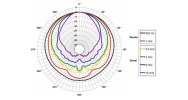OrganicZed
Fractal Fanatic
I love to see it when someone gets the help they need to solve their tone problems.
See - that’s the kind of technical explanation I am simply ill equipped to make!Actually, all sound travels is a straight line — regardless of frequency — unless something reflects it or refracts it. The difference is how efficiently a given speaker radiates sound in different directions. At 5 KHz, a typical speaker cabinet concentrates the sound in a narrow cone directly in front of the speaker. At 50 Hz, the same speaker radiates sound at roughly equal levels in all directions. In other words, if you're off axis from a speaker, the sound you'll hear will have lots of lows and not much highs.
 But not Rex, he’s got it!
But not Rex, he’s got it!I can’t technically explain it, but in my own personal experience, i just prefer the coaxial FRFR sound. That doesn’t mean I can’t be convinced with a non-coaxial speaker in the future, but so far for me, my ears like those best with my Axe-Fx III for a stage gig.That’s something that the coaxial speakers seem to be taming, or controlling better.

So I’ve done reasesrch, any recommended height for best results? I’m currently right around 54 inches
I love to see it when someone gets the help they need to solve their tone problems.
Sound can radiate in a straight line and still radiate at different strengths in different directions. Light also travels in straight lines, but a flashlight puts out more light in front than in back.If sound travel linearly, it can't radiate non linear from the speaker.
Yes, that will change the sound. If you rotate the speaker 180°, so it's facing the wall, it will sound radically different.If you rotate the monitor you will noy change the speaker sound.
That's a towel over yur speaker. TOTALLY different sonic situation than the blanket which was discussed in this thread.So from now on, first send a pic showing your speakers.
I don't know what's going on, but my speakers sounds muffled.View attachment 103864
I recently read in another thread that the hardcore pros turn off their cab sims in that situationSo from now on, first send a pic showing your speakers.
I don't know what's going on, but my speakers sounds muffled.View attachment 103864
Thank's for this. The screenshot is different from what my FM3 shows in editor (sliders) - am I missing something?Try this preset that I use live and see if it changes anything. Set your output EQ to the pic below
No. The Doppler effect is completely compatible with straight-line sound propagation.Wouldn't the doppler effect be a case of sound travelling non-linearly?
Yup.No. The Doppler effect is completely compatible with straight-line sound propagation.
Rex, a speaker to me is a transducer: the coil, the cone, the basket and the assembly.Sound can radiate in a straight line and still radiate at different strengths in different directions. Light also travels in straight lines, but a flashlight puts out more light in front than in back.
If you put a speaker 5 km in the air, with no reflecting surfaces anywhere near, it will still put out more treble to the front than to the back.
In the industry, that is called the “driver.” The rest is called the “cabinet.”Rex, a speaker to me is a transducer: the coil, the cone, the basket and the assembly.
Also because of other factors, including the fact that the cone is moving forward and backward, and not sideways.If you put a speaker in the air, you will get more volume "in front" because of the cone shape and the basket.
You’re right that the cabinet affects directivity. And you’re right that the room itself affects response. But even just the driver itself has frequency-dependent directional characteristics.If you put a speaker in a cabinet, you affect directivity, and eq (resonance). Usually speaker is in cabinet, more directional in front. If you point a cabinet into the wall, it will absorb the high. It's not the speaker that change eq, it's the room absorbing the frequency. The monitor/cab position is very important... often more than speaker dispersion!
Let me know what you think!

